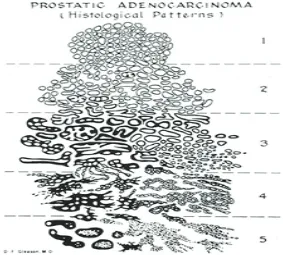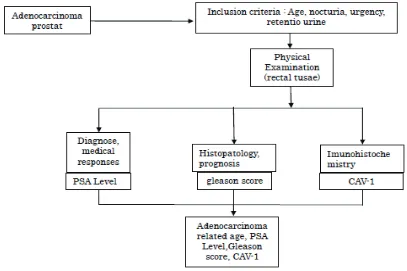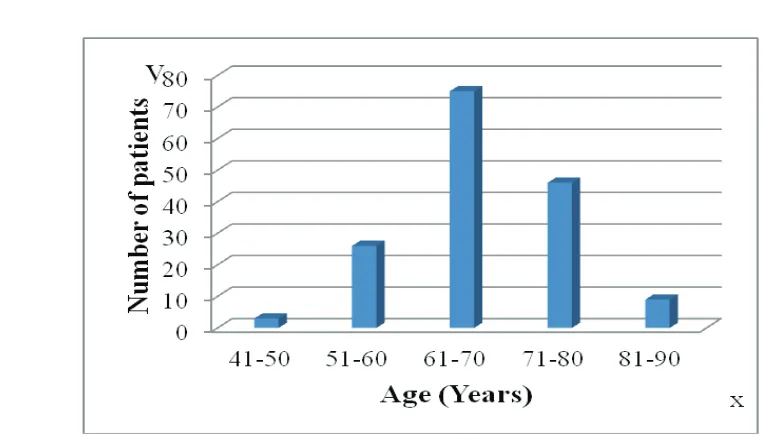Pattern of Prostate Specific Antigen and Gleason Score in Relation to
Imunohistochemistry Features in Prostate Adenocarcinoma Patients
in Dr. Hasan Sadikin General Hospital
Azela Glady,1 Endah Hamidah,1 Rahmat Budi Prasetyo,1 Agung Budi Sutiono2
1Faculty of Medicine, University of Jenderal Achmad Yani
2Department of Neurosurgery, Faculty of Medicine, Universitas Padjadjaran-Dr. Hasan Sadikin General Hospital
Abstract Objective: To review the correlation between prostate specific antigen (PSA)
and Gleason score and Cav-1 for diagnosing prostate adenocarcinoma.
Methods: Data were collected from one hundred fifty-nine patients with prostate adenocarcinoma at the Department of Urology, Dr. Hasan Sadikin General Hospital in the period of January 2008–December 2010. The PSA levels were measured and classified into <4 ng/ml, 4–10 ng/ml, and >10 ng/ ml. The results were then analyzed and compared to the imunohistochemistry
(caveolin-1) staining in the literature. The Gleason score was also noted and
analyzed.
Results: This study confirmed that positive caveolin-1 expression was related to the clinical markers of disease progression and was predictive of poor clinical outcome after surgery. The PSA results showed that one hundred fourty-one adenocarcinoma patients had a PSA level of >10 ng/ml with Gleason score of gleason 5–6 as the most common score. However, there was no correlation between PSA and Gleason score and caveolin-1 for diagnosing
prostate adenocarcinoma.
Conclusions: Caveolin-1 cannot be used to measure Gleason and PSA score due to different markers that have various advantages and disadvantages to predict carcinoma prostate. Therefore, further studies are needed.
Keywords:Gleason score, imunohistochemistry, prostate adenocarcinoma,
Azela Glady, Faculty of Medicine, Universitas Jenderal Achmad Yani
Jl. Jenderal Sudirman, Cimahi, Indonesia e-mail: gladyazela@gmail.com
Introduction
Prostate adenocarcinoma is the malignancy that is most frequently found and also the
second most common cause of death in men.1,2
Adenocarcinoma of the prostate generally occurs at the age of >50 years but does not generate any clinical symptoms. Hence, most patients come at advanced stages. About
20% of the prostate adenocarcinoma is found
incidentally in a histopatological procedure for examining the prostate gland based on the indication of hyperplasia.3
Adenocarcinoma prostate showed a high morbidity and mortality with a number of
234.460 diagnosed and 27.350 passed away
after diagnosed.4 A study found more than
230.000 new cases and 30.000 of them was death.5
Many ways were conducted to diagnose adenocarcinoma in its early stage, one of the strategy is by measuring the prostate specific antigen (PSA) level.6,7 Prostate specific antigen
is a glicoprotein produced by the prostate gland with a normal level <4 ng/ml. A number of studies showed that PSA can be used to
diagnose adenocarcinoma prostate with 75% accuration.8,9
Biopsy and histopatology are alternative ways to diagnose adenocarcinoma prostate.
The Gleasson score can be used to determine
when the histopatology analysis was carried
out. The Gleasson score is an indication for
the malignancy of adenocarcinoma prostate
score indicates prostate cancer based on its
microscopic appearance. Thus, the higher the
Gleasson score means it is more malignant
but with poor prognosis. The five basic grade
patterns are used to generate a histologic
score and measure the Gleason score, which can be ranged from 2 to 10, by adding the primary and the secondary grade patterns. The primary pattern is the one that is predominant in the area, by a simple visual inspection. The secondary pattern is the second most common pattern. If only one grade is in the tissue sample, that grade is multiplied by two to give a score. According to the Gleason approach of 1977, if the second grade is less than 3% of the total tumor, it is ignored, and the primary
grade is again doubled to give the Gleason score (Fig. 1).5,10–14
Furthermore, a previous study identified and characterized clearly the overexpression
of caveolin-1 (cav-1) gene occurring in a
mouse model of prostate carcinoma and a human prostate carcinoma. In several clinical
cases which determined the localization of prostate carcinoma showed cav-1 expression is a novel prognostic marker with independent
predictive value of biochemical recurrence.12
Adenocarcinoma is one of the major problems found in male aged above 50 years. Therefore, an early detection is very usefull to reduce morbidity for adenocarcinoma prostate.
Methods
One hundred fifty-nine data of patients were taken from medical records with inclusion criterion, patients who were diagnosed with adenocarcinoma in the period 2011– 2012 in Dr. Hasan Sadikin General Hospital, Bandung with symptoms of nocturia, urgency, retention urine and risk factor >50 years old.
Gleason Score from Lower to Higher.1 Gleason Pattern 1: Circumscribed Nodule
of Closely Packed Uniform Glands, Gleason Pattern 2: Circumscribed Nodule of Loosely Packed Slightly Variable Glands, Gleason Pattern 3: Single Glands of Variable Size and Density, with an Infiltrative Pattern, Each Separated by at Least a Strand of Stroma, Gleason Pattern 4: Ragged Infiltration with Poorly Formed Glands or Sheets and Cords of Fused Glands, Poorly Formed Glands Includes Small Nests of Cells with only a Rudimentary Formed Lumenal Space (almost Rosette Like), Gleason Pattern 5: Ragged Infiltrative Single cells, Cords or Sheets, Granular
They performed rectal tussae examination, measured the PSA level and histopathology to obtain the Gleason score. The prostate specific antigen level was measured and classified into <4 ng/ml, 4–10 ng/ml, >10 ng/ml. Those results were analyzed and compared into the imunohistochemistry (caveolin-1) of staining
in the literature. The Gleason score was also noted (Fig 2).
Results
This study found that out of 156 patients, most
of adenocarcinoma prostate patients occured
in male who were >50 years old, with the
highest incidence rate occuring in 75 patients
aged 61–70 years (Fig. 3).
Additionally, the prostate specific antigen level was classified into <4 ng/mL usually normal in male, 4–10 ng/mL which is called the grey area, and >10 ng/mL which strongly indicates carcinoma. Apparently, one hundred fourty-one adenocarcinoma patients had PSA level >10 ng/ml (Fig. 4). Moreover, the Gleason score is classified into Gleason 2–4 which
means good differentiated, Gleason 5–6 means moderate differentiated, Gleason 7–10 means poorly differentiated, and eighty patients had Gleason score 5–6 (Fig. 5).
Cav-1 immunoreactivity was detected in the cytoplasm of tumor cells in a granular pattern after comparing with immunohistochemistry from literature. The validity of the staining reactions was confirmed by the strong staining
reactions characteristic of smooth muscle and
endothelial cells within the stroma, although
the proportion of cav-1-positive tumor cells were varied within individual specimens.
Furthermore, cav-1 reactivity was not detected in histologically normal epithelial cells in areas adjacent to the tumor. The patient group with a PSA level >10 ng/mL was found to have
the highest rate of cav-1-positive tumors.
However, no significant correlation between cav-1 expression and preoperative serum PSA level was found (p=0.203, Spearman correlation test) and there was a tendency toward a higher incidence of cav-1 expression with a higher Gleason score, and no significant correlation between cav-1 expression and Gleason score was found (p=0.100; Spearman
correlation test). The description of Caveolin-1
immunostaining in moderately differentiated
prostate carcinoma cases and Caveolin-1
expression as demonstrated by avidin-biotin complex immunohistochemical staining in moderately differentiated prostate carcinoma
cases are shown (Fig. 6).20
Discussion
Adenocarcinoma prostate generally occurs at the age of >50 years but does not generate
any clinical symptoms. In the result, it showed
that most of the patients with adenocarcinoma
prostate are between 61–70 years old. The results have similarity with a previous study in dr. Moewardi Surakarta Hospital, the most common patients were aged 65–75 years.13
Furthermore, another study in Barbados also
revealed the most common age was between
65–75 years old.14 This is similar to the theory
that adenocarcinoma is related with age and
usually occurs at the age >50 years old. The serum PSA screening has led to a
dramatic increase in the diagnosis of prostate
Fig. 3 Age Distribution
carcinoma as well as in the number of male
undergoing radical prostatectomy in the past
decade.15,16 In the United States, the number
of newly diagnosed prostate carcinoma cases and cancer specific mortality appear to be declining; inspite of this, it is unclear whether
these reductions are related to increased
screening and earlier aggressive treatment, misclassification of cause of death, or more complex population dynamics.17 This PSA
study showed similarity with a study from dr. Kariadi Semarang from 2000–2006 which found PSA >10 ng/mL in an adenocarcinoma patient. Thus, the finding in this study is
similar to the previous study. The increase in serum PSA observed in prostate cancer patients is not due to increased expression of PSA on a cellular level. However, it is rather
a tumor-associated disruption of the normal prostate tissue architecture that leads to the
increased release of PSA into peripheral blood. Prostate specific antigen was first approved in 1986 by the Food and Drug Administration (FDA) to monitor response in patients treated for prostate cancer and subsequently as a diagnostic marker in 1994. Even at the time of its discovery, however, three inherent limitations of PSA as a biomarker were evident.
Fig. 5 Adenocarcinoma Prostat Correlation with Gleason Score
Cav-1 in normal prostate was localized primarily to smooth muscle cells and endothelial cells in the stroma with negatively stained glandular epithelia (a). In contrast, cav-1 immunostaining was present in the cytoplasm of tumor cells (b)20
First, PSA is not regarded a prostate cancer specific antigen. Second, PSA does not reliably
predict the grade or stage of prostate cancer
at diagnosis. Third, PSA reflects tumor volume, however does not functionally contribute to the patophysiology of the tumor progression. Therefore, PSA does not distinguish clinically significance from insignificant prostate cancer. For these reasons, the PSA is most useful as
a prognostic tool when combined with other clinicopathologic parameters.18
The findings of this study related to the Gleason score show similarity compared to the previous studies. Besides, a study showed
that most of the patients had Gleason score
5–6.19 It showed that most of adenocarcinoma prostates occured when the score is moderate
differentiated and poorly differentiated. The study showed that adnocarcinoma prostate usually had no symptom meaning that patients did not realize suffering from adenocarcinoma. Meanwhile, the increase of the PSA level can be caused by hiperplasia prostate, inflammation or cancer in prostate, thus, the PSA level needs
to be combined with rectal tusae which in
adenocarcinoma usually has nodules in the prostate. Furthermore, the serum PSA levels, the Gleason score, and clinical stage have
been shown to be useful in the preoperative
prediction of final pathological stage. However, in the middle ranges of a given index, these indices lose predictive power. Therefore,
additional individual predicting methods are
needed, such as molecular markers.20
The cav-1 is a major structural coat protein of caveolae, specialized plasma membrane
invaginations involved in multiple cellular
functions including molecular transport, cell adhesion, and signal transduction. In clinically
localized prostate cancer, the cav-1 is focally expressed by malignant epithelial cells. The cav-1 expression proportionally increases in high-grade primary tumors with lymph node metastases and in metastatic lymph nodes.18
Univariate Cox proportional hazards analysis demonstrated that positive cav-1 expression
was predictive of a shorter time to disease
progression after the radical prostatectomy. The mechanism for increased expression of
cav-1 in aggressive prostate cancer remains
unclear, however, when compared with serum PSA, serum cav-1 more specifically identifies clinically aggressive disease. This likely reflects the fact that, unlike PSA, cav-1 biologically
contributes to malignant progression and the development of castrate-resistance. For
the same reason, serum cav-1 measurement may also prove useful as a biomarker in other prostate cancer disease states. Eventhough, there is significantly result between cav-1 and the Gleason score. Obviously, there is no
correlation between the serum cav-1 levels with the Gleason score using the Spearman
correlation. This might be due to the lack of
data.
In conclusion, the positive cav-1 expression is related to the clinical markers of the disease
progression and is also predictive of a poor
clinical outcome after the surgery. Therefore, there is no correlation between the PSA and
the Gleason score with cav-1 for diagnose of adenocarcinoma prostate. It means that we
cannot predict the Gleason score and PSA score only with cav-1. Due to those different markers advantages and disadvantages in predicting the carcinoma prostate, therefore, it need a further study.
References
1. Li J, Djenaba JA, Soman A, Rim SH, Viraj A,
Master. Recent trends in prostate cancer incidence by age, cancer stage, and grade, the United States, 2001–2007. Prostate Cancer. 2012 [cited 2014 Nov 3]:[about 8 p.]. Available from: http://www.hindawi.com/journals/ pc/2012/691380/.
2. Eeles R, Goh C, Castro E, Bancroft E, Guy M,
Olama AAA, et al. The genetic epidemiology of prostate cancer and its clinical implication. Nat
Rev Urol. 2014;11(1):18–31.
3. Miah S, Catto J. BPH and Prostate cancer risk.
Indian J Urol. 2014;30(2):214–8.
4. Beauchamp RD, Evers BM, Mattox KL. Sabiston
Textbook of surgery the biological basis of modern surgical practice, 18th ed. Philadelphia:
Saunders Elsevier; 2008. p. 2277–80.
5. O’Leary JP. The physiologic basis of surgery. 4th ed. Philadelphia: Lippincott Williams &
Wilkins; 2008. p. 669–70.
6. Vickers. AJ, Brewster SF. PSA Velocity and doubling time in diagnosis and prognosis of
prostate cancer. Br J Med Surg Urol. 2012;5(4): 162–8.
7. Gupta A, Gupta D, Raizada A, Gupta NP, Yadav
study on reference range of serum prostate specific antigen levels. Indian J Med Res. 2014;140(4):507–12.
8. Pakasi RDN. Total prostate specific antigen, prostate specific antigen density and
histopatologic analisis on benign enlargement
of prostate. IJMS. 2009;5(1):263–74.
9. Heijnsdijk EAM, Wever EM, Auvinen A, Hugosson J, Ciatto S, Nelen V, et al. Quality of life effect of prostate specific antigen screening. N Engl J Med. 2012; 367(7):595–605.
10. Khani F1, Epstein JI. Prostate biopsy
specimens with Gleason 3+3=6 and intraductal carcinoma: radical prostatectomy findings and clinical outcomes. Am J Surg Pathol. 2015 Oct;39(10):1383–9.
11. Ko K, Jeong IG, Choi WS, Lim JH, Suh JH, Ku
JH, et al. Effect of Gleason scores of lymph
node metastases on prognosis of patients
with prostate cancer. Int J Clin Exp Pathol. 2014;7(9):6141–8.
12. Yang G, Truong LD, Wheeler TM, Thompson
TC. Caveolin-1 expression in clinically confined
human prostate cancer: a novel prognostic
marker. Cancer Res. 1999;59(22):5719–23.
13. Endi P, Soeharto W. Penanganan Karsinoma
Prostat di RSUD Dr. Moewardi Surakarta Januari 2000- Desember 2006. Surakarta 2006
14. Hennis AJ, Hambleton IR, Wu SY, Skeete
DH, Nemesure B, Leske MC. Prostate cancer incidence and mortality in barbados, west
indies. Prostate Cancer. 2011 [cited 2014 Nov 3]:[about 10 p.]. Available from: http://www. ncbi.nlm.nih.gov/pmc/articles/PMC3200283/.
15. Egawa S, Suyama K, Ohori M, et al. Early detection of prostate cancer. Results of a
prostate specific antigen-based detection program in Japan. Cancer. 1995;76(5):463–72.
16. Fall K, Garmo H, Andren O, Axelson AB,
Adolfsson J, Adami HO, et al. Prostate Specific Antigen Levels as a Predictor of Lethal Prostate Cancer. J Natl Cancer Inst. 2007;99(7):526–32.
17. Hankey BF, Feuer EJ, Clegg LX, Hayes RB,
Legler JM, Prorok PC, et al. Cancer surveillance series: interpreting trends in prostate cancer part I: evidence of the effects of
screening in recent prostate cancer incidence, mortality, and survival rates. J Natl Cancer Inst.1999;91(12):1017–24.
18. Corn PG, Thompson TC. Identification of a novel prostate cancer biomarker, caveolin-1: Implications and potential clinical benefit. Cancer Management and Research. 2010;2:(1)111–22.
19. Stark JR, Perner S, Stampfer MJ, Sinnott JA, Finn S, Einsenstein AS, et al. Gleason Score and Lethal Prostate Cancer: Does 3+4=4+3?. JCO. 2009; 27(21):3459–64.
20. Lowrance WT, Scardino PT. Predictive Models



